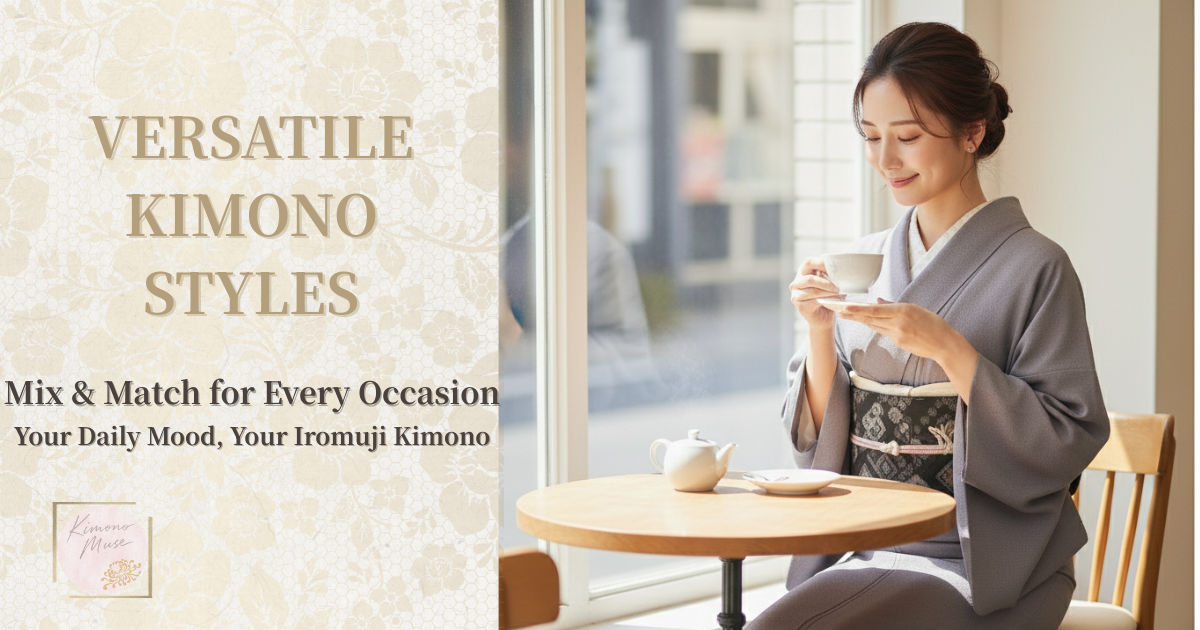“Do I really need to own several kimonos to suit every occasion?”
That’s a question I often hear.
In truth, all you need is one ace piece—a kimono that can transform effortlessly depending on how you style it. With the right obi and accessories, it can look formal or casual, refined or relaxed—like a kind of quiet magic.
At Kimono Muse, our top recommendation for this ultimate mix-and-match hero is the iromuji, a single-colored kimono loved for its timeless elegance and versatility.
In this article, we’ll show you how to make the most of an iromuji—exploring the “transformation recipes” of obi and accessories that let you adapt beautifully to any occasion.
Find your one perfect kimono, and discover how enjoyable and free the world of kimono dressing can truly be.
The Iromuji: The Quiet Hero of Versatile Kimono Dressing
The secret lies in the family crests, or mon, that are placed on the back and sleeves of the kimono.
The number of these crests determines the formality level—and that’s the hidden key that allows an iromuji to transform for different occasions.
Take a look at the chart below to see how the number of crests changes the rank of the kimono, and which situations each style is suited for.
| Number of Crests (Mon) | Formality & Features | When to Wear |
|---|---|---|
| Five Crests (Itsutsu-mon) | The “most formal” specification—just below the black tomesode in rank. Ideal for the highest level of formality. | Award ceremonies, family weddings, and other prestigious occasions. |
| Three Crests (Mitsu-mon) | Semi-formal attire equal in rank to the hōmongi (visiting kimono). Combines dignity with a touch of splendor. | School entrance and graduation ceremonies, Shichi-Go-San celebrations, shrine visits, and other auspicious events. |
| One Crest (Hitotsu-mon) | Kimono Muse’s recommendation! The ultimate “everyday-formal” piece—perfectly balanced between elegance and versatility. | Tea gatherings, friends’ celebrations, and semi-formal lunches or dinners. Works beautifully with a nagoya obi for a smart casual look. |
| No Crest | Relaxed everyday wear. Similar in formality to komon or tsumugi kimono, allowing for free styling. | Ideal for theater outings or casual lunches, but not suited for formal occasions. |
In recent years, more people have begun wearing iromuji without any crests, pairing them with elegant, high-rank fukuro obi belts.
This creates a semi-formal impression—similar to wearing an iromuji with one crest.
When choosing your “ace kimono,” it’s helpful to start by deciding whether to have one crest (hitotsu-mon) or none at all.
Either choice will give you a dependable companion that adapts beautifully to different occasions and seasons.
Styling the One-Crest Iromuji – Graceful Coordination of Obi and Accessories by Occasion
Now that we’ve discovered that the iromuji with one crest or no crest makes the most versatile “ace kimono,”
let’s move on to the practical chapter—how to style it gracefully for different occasions.
We’ll start with the most adaptable and elegant choice: the one-crest iromuji, a quiet powerhouse that can hold its own even in formal settings.
By changing the obi and small accessories—such as the obijime (decorative cord) and obiage (sash cover)—you can completely transform its impression.
Let’s explore these transformation recipes across three levels of formality: semi-formal, smart casual, and everyday chic.
Scene 1: The Iromuji as Formal Elegance
We begin with the most formal expression of the iromuji—a style that embodies grace and celebration.
A one-crest iromuji truly shines on special occasions: weddings and receptions of friends, your child’s entrance or graduation ceremonies, Shichi-Go-San celebrations, or refined tea gatherings.
At this level, the iromuji holds the same formality rank as a hōmongi or tsukesage, making it a perfectly appropriate choice for such auspicious events.
The secret to coordination lies in harmony and restraint.
Choose obi and accessories woven with gold or silver threads to elevate the formality, and aim for a tone that conveys both elegance and a heartfelt sense of celebration.
Here’s your transformation recipe for formal occasions
| Item | How to Choose & Styling Tips |
|---|---|
| Occasion | Weddings of friends, school entrance or graduation ceremonies, Shichi-Go-San celebrations, formal tea gatherings, and elegant parties. |
| Obi (Belt) | Choose a fukuro obi woven with gold or silver threads for a refined, formal look. Patterns such as auspicious motifs, yūshokumon (courtly designs), or Shōsōin-inspired classics are ideal. |
| Obijime (Decorative Cord) | Opt for a flat, formal-style obijime (hiragumi) in white or pale tones. Gold or silver threads add subtle sophistication. |
| Obiage (Sash Cover) | Typically white. Embroidered silk with gold or silver accents, or pale-colored rinzu (damask) or chirimen (crepe) fabrics also work beautifully. |
| Nagajuban (Under-Kimono) | Plain white or soft pastel tones convey cleanliness and grace. |
| Zōri & Bag | A coordinated formal set in gold, silver, or white tones. Rikyu-inspired handbags or other elegant designs are recommended. |
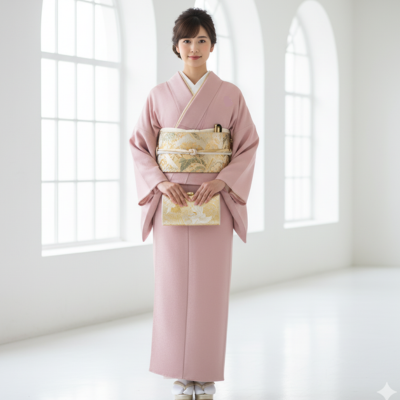
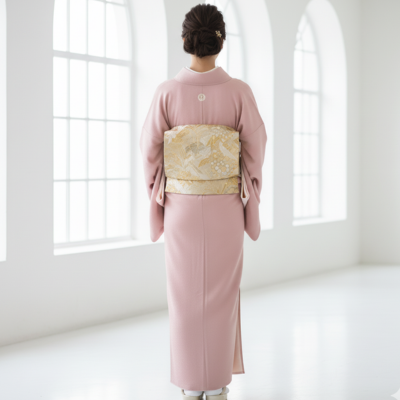
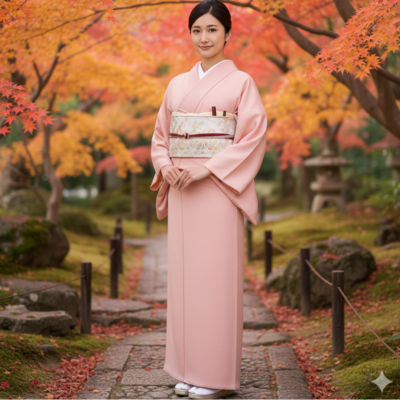
Scene 2: The Iromuji in Semi-Formal Elegance
A one-crest iromuji isn’t just for formal ceremonies—it also shines as a refined choice for semi-formal occasions.
When a hōmongi or tsukesage feels too formal, and a komon or tsumugi feels too casual, the iromuji steps in beautifully as the perfect in-between.
Think of scenes like a theater outing, a lunch at a hotel, or a slightly dressy dinner gathering—it adds quiet sophistication to any setting.
The key to this coordination is to set aside the gold and silver accessories used for formal wear.
Rather than emphasizing formality, focus on a sense of refined style—introduce gentle color contrasts, subtle textures, or elegant motifs to express your individuality with grace.
Here’s your transformation recipe for semi-formal occasions
| Item | How to Choose & Styling Tips |
|---|---|
| Occasion | Theater outings, hotel lunches, refined dinner gatherings, or semi-formal social events with friends. |
| Obi (Belt) | Select a Nagoya obi or a chic Shara-bukuro obi (a lighter, woven type). Avoid strong metallic threads—opt for subtle patterns and refined textures for a polished yet relaxed impression. |
| Obijime (Decorative Cord) | Choose cords without gold or silver, in soft tones that are easy to tie. A yurugumi (loosely woven) style works well for natural elegance. A three-piece combination (obijime + obidome) adds a graceful touch. |
| Obiage (Sash Cover) | Enjoy light colors or those that complement your kimono and obi. Fabrics like rinzu (damask) or chirimen (crepe) in soft patterns or subtle shibori (tie-dye) add individuality. |
| Nagajuban (Under-Kimono) | White or pale colors are always appropriate, but a glimpse of a patterned or colored underlayer from the sleeves adds personality and charm. |
| Zōri & Bag | Choose slightly casual formal accessories. Enamel, embossed leather, or elegant handbags such as Rikyu-style pieces coordinate beautifully as standalone highlights. |



Styling the Uncrested Iromuji – Graceful Versatility for Everyday Wear
We’ve seen how the one-crest iromuji shines as the go-to piece for formal and semi-formal occasions.
But if you’d like to enjoy kimono more casually — with ease and freedom — the uncrested iromuji becomes your ultimate everyday ace.
Without the formal crest, this style fits perfectly into the “smart casual” and “everyday chic” categories of kimono dressing.
Think of it as the kimono equivalent of a refined one-piece dress — polished yet relaxed, adaptable through your choice of obi and accessories.
Here, we’ll explore transformation recipes for coordinating the uncrested iromuji in stylish, casual ways.
Scene 1: The Iromuji for Refined Social Occasions
An uncrested iromuji may not be considered formal attire, but it holds the same charm as a simple, high-quality one-piece dress in Western fashion.
Just as pairing a dress with a tailored jacket can create a polished, professional look, an uncrested iromuji can also appear suitably dignified—depending on the obi you choose.
It’s perfect for occasions where you wish to show respect without appearing overly formal—such as visiting a senior acquaintance, attending a workplace gathering, or a semi-formal luncheon.
The key to styling is balance.
Select an obi with subtle gold or silver threads, or one featuring traditional motifs like yūshokumon (courtly patterns) to express quiet refinement.
A white han-eri (half-collar) adds a crisp, graceful touch, completing an ensemble that conveys both elegance and consideration.
| Item | How to Choose & Styling Tips |
|---|---|
| Occasion | Visiting senior acquaintances, workplace appreciation gatherings, or thank-you dinners with mentors or colleagues. |
| Obi (Belt) | Choose a fukuro obi with subtle gold or silver threads, or a high-grade Nagoya obi woven with elegant motifs such as yūshokumon (courtly designs). Aim for refinement rather than brilliance. |
| Han-eri (Half-Collar) | Pure white is ideal. Keep the neckline clean and crisp for a polished, graceful impression. |
| Obijime & Obiage | Select slightly formal items similar to those in the semi-formal scene. A yurugumi obijime (softly woven cord) works beautifully; for the obiage, choose pale-toned chirimen (silk crepe) to maintain quiet elegance. |
| Zōri & Bag | Choose refined pieces suited for semi-formal wear—materials with a gentle sheen, or simple designs that convey understated luxury. |
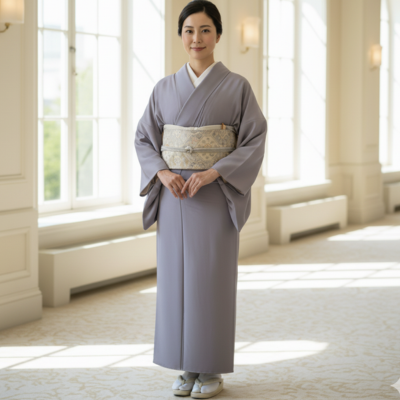
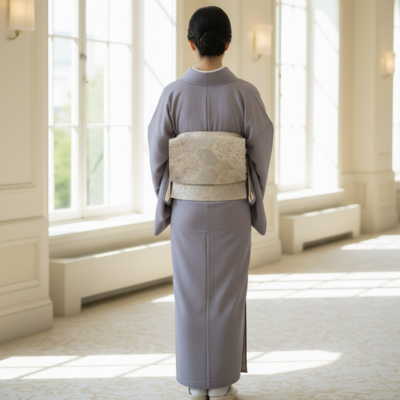
Scene 2: The Iromuji in Effortless Everyday Elegance
Just like pairing a simple dress with a casual jacket or a soft stole, an uncrested iromuji can easily transform into a stylish town kimono with a change of obi or accessories.
It’s perfect for everyday outings—meeting friends for lunch, relaxing at a café, or strolling through the city.
In these casual moments, the iromuji becomes a graceful companion that blends comfort with quiet sophistication.
The key to styling is to let go of formality from the previous scene.
Choose an “oshare-mono” obi—a playful, non-metallic belt with personality—and enjoy combining colors and patterns in the same way you might coordinate Western clothing.
Express yourself freely through soft hues and subtle textures, and discover the joy of everyday elegance in kimono.
| Item | How to Choose & Styling Tips |
|---|---|
| Occasion | Lunch with friends, café outings, shopping trips, or a relaxed stroll through town. |
| Obi (Belt) | Pair with a dyed Nagoya obi for a light, effortless look. Seasonal patterns or playful designs work beautifully with neutral-toned iromuji, creating a chic casual balance. |
| Han-eri (Half-Collar) | Instead of white, try patterned or colored han-eri to add brightness and a hint of personality around the face. It brings a playful, cheerful impression. |
| Obijime & Obiage | Feel free to express individuality through color contrast. Combine a sanbu-himo (thinner cord) with an obidome (decorative clasp) for a stylish, polished touch. |
| Zōri & Bag | Choose light materials or contemporary designs for a casual finish. Small handbags, enamel or woven zōri, or even modern Ryū bags pair perfectly with this relaxed style. |

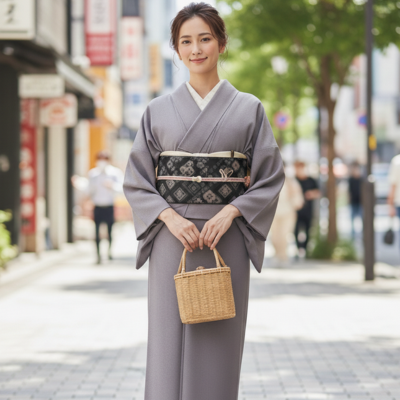
The Iromuji: A Timeless Companion for a Graceful Kimono Life
How did you find it?
Many people imagine that they need several kimonos for different occasions—but as you’ve seen, one iromuji can transform like magic depending on your choice of obi and accessories, your personal transformation recipe.
In this article, we introduced two versions of the “ultimate ace” for your kimono wardrobe:
1. The One-Crest Iromuji
Perfect for those who want to cover both formal and semi-formal occasions.
It’s ideal for children’s ceremonies, tea gatherings, or weddings—any setting that calls for elegance and respect.
2. The Uncrested Iromuji
Best for those who wish to enjoy kimono more casually and freely.
Like a refined one-piece dress, it’s versatile enough for dinners, café outings, and even everyday strolls.
Picture your own lifestyle and ask yourself:
Which ace would suit me best?
At Kimono Muse, we believe the iromuji is truly a “universal kimono”—a single garment full of possibility.
Don’t overthink it—start by finding your own ace piece, and enjoy the art of coordination through obi and accessories.
From there, you’ll discover a freer, more personal way to live beautifully in kimono.
✿ Fumi’s Kimono Diary ✿
Lately, I’ve been wearing my lavender-gray iromuji quite often.
The quiet moment of choosing an obi in front of the mirror feels like a small reset for my mind.
Today, I paired it with a white Nagoya obi.
Its subtle pattern shimmers gently in the light—so refined that even as I sat by a café window, sipping tea, I felt my posture straighten a little.
The iromuji truly is a mysterious kimono.
It isn’t flashy, yet whether I want to feel calm or just a little bit radiant, this one piece is always enough—it gives me a quiet sense of comfort.
Each time I wear kimono, I become more aware of the changing seasons and the shifting moods within myself.
Perhaps that’s what “the richness of wearing kimono” means to me.
